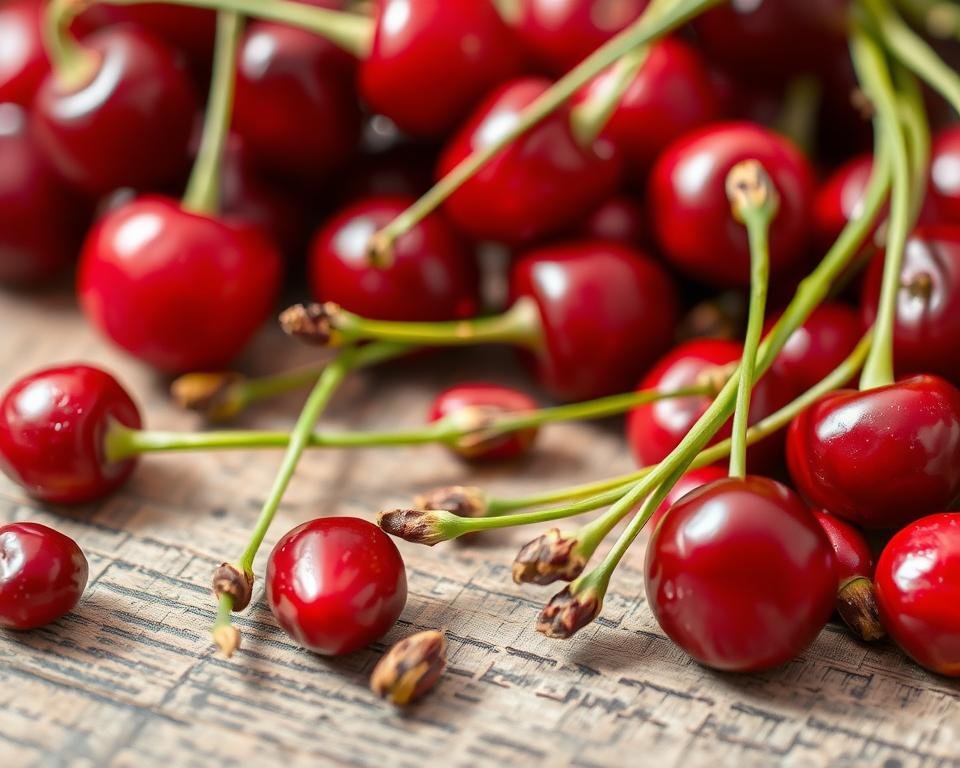Many pet owners wonder what human foods are safe for their dogs. Cherries are a tricky case. Cherries, like peaches and apricots, can be good or bad for dogs. The cherry flesh is safe and has nutrients like antioxidants and vitamins A and C.
But, the pits, stems, and leaves of cherries are poisonous. They contain cyanide, which can be deadly to dogs. It’s important to be careful with cherries for your dog.
While cherry flesh is nutritious, the dangers of pits and leaves are real. Removing these parts is key to keeping your dog safe. This prevents cyanide poisoning and other serious health issues.
Knowing the risks and benefits of cherries helps you feed your dog safely. You can then decide if cherries are right for your pet’s diet.
https://healthdy.com/home-remedies-for-fleas-on-dogs-how-to-protect-your-pet-naturally/
Understanding the Risks and Benefits of Cherries for Dogs
Feeding cherries to dogs can be tricky. Cherries have good stuff like antioxidants and vitamins, but their pits and stems are very bad. Knowing about cherries and their dangers is key for pet owners.
Basic Cherry Anatomy: Flesh, Pits, and Stems
Cherries have three parts: the fruit, the hard pit, and the stem. The fruit is okay for dogs in small amounts. But the pits, stems, and leaves have cyanide, which is very harmful.
Nutritional Value of Cherry Flesh
The fruit of cherries is good for dogs. It has antioxidants, fiber, and vitamins A and C. It also has melatonin, which helps with sleep. These nutrients can help with digestion and immune health.
Potential Health Benefits for Dogs
Cherries might have some good points. The fruit’s antioxidants and fiber can help with digestion. Melatonin might help with sleep. But, the dangers of the toxic parts are much bigger.
Be careful when giving cherries to your dog. Only give them the fruit, not the pits or stems. Talk to your vet about how much and how often to give them to keep your dog safe.
“While the flesh of cherries can provide some nutritional benefits, it’s essential to exercise caution when feeding cherries to dogs. The pits, stems, and leaves contain cyanide, which can be highly toxic and potentially life-threatening.” – Dr. Jane Doe, Veterinarian
Can Dogs Eat Cherries: Safety Guidelines and Precautions
Cherries are a tasty summer fruit, but they’re not always safe for dogs. While dogs can eat the fleshy part of cherries, it’s not usually a good idea. There are risks involved.
If you want to give cherries to your dog, make sure to remove the pits, stems, and leaves. These parts have cyanide, which is toxic to dogs. Only give cherries as a small part of their daily food. Avoid giving them maraschino cherries because they have added sugars and preservatives.
Before giving cherries to your dog, wash them well. This removes any pesticides or harmful substances. Watch your dog for any signs of upset stomach or allergies after they eat cherries.
“While dogs can technically eat the fleshy part of cherries, it’s generally not recommended due to the associated risks.”
When it comes to your dog’s health, it’s always safer to be cautious. By following these guidelines, you can give your dog cherries sometimes. This way, you can enjoy cherries with your furry friend while keeping them healthy.
The Dangers of Cherry Pits and Stems
Cherries can be good for dogs, but the pits, stems, and leaves are very dangerous. These parts have cyanogenic glycosides. This toxin can release cyanide when chewed or digested.
Understanding Cyanide Toxicity
Cyanide is very poisonous and can be deadly to dogs. The danger depends on the dog’s size and how the pits are eaten. Black cherry pits have about 78 micrograms of cyanide per seed.
The LD50 (lethal dose for 50% of the population) for dogs is 5-6 mg/kg. Even the LDLo (lowest observed lethal dose) for dogs is 1.7 mg/kg.
Warning Signs of Cherry Poisoning
If a dog eats cherry pits, stems, or leaves, they might show signs of cyanide poisoning. These signs include dilated pupils, trouble breathing, and bright red gums. They might also pant, feel weak, and go into shock.
These symptoms can start in 15-20 minutes and get worse fast.
Emergency Response Guidelines
- If you think your dog ate cherry pits, stems, or leaves, call your vet right away.
- Look for signs of intestinal blockage like vomiting, less appetite, and constipation.
- Don’t try to make your dog vomit or give them any treatment without a vet’s advice.
Quick action and vet care are key to treating cyanide poisoning in dogs. Knowing the risks and being careful can help keep your dog safe from cherry pits and stems.
Safe Ways to Prepare Cherries for Your Dog
Feeding cherries to your dog needs to be safe first. Cherries can be safe for dogs if given in small amounts. But, you must take steps to keep your dog safe.
Always choose fresh, unprocessed cherries. Make sure to wash them well. Then, remove the pits, stems, and leaves because they are toxic to dogs. Cut the cherries into small pieces for smaller dogs.
- Blend cherries with other dog-safe fruits to create a nutritious smoothie.
- Mix cherries with plain, sugar-free yogurt for a tasty and digestible treat.
- Freeze cherries in a KONG toy or other puzzle feeder to keep your pup entertained and engaged.
- Dehydrate cherries at home using a food dehydrator for a healthier alternative to store-bought dried treats.
Even though cherries can be a tasty and occasionally healthy snack for dogs, introduce them slowly. Also, only give them in small amounts. Talk to your vet before adding cherries to your dog’s diet.

“Proper preparation and serving size are key when it comes to feeding cherries to your four-legged friend.”
Serving Sizes and Portion Control
Feeding your dog cherries needs careful thought. The right amount depends on your dog’s size and weight. Here’s a simple guide:
Extra-small dogs (2-20 lbs) get one cherry. Small dogs (21-30 lbs) can have up to two cherries. Medium dogs (31-50 lbs) can enjoy up to four cherries.
Large dogs (51-90 lbs) can have up to five cherries. Extra-large dogs (91+ lbs) can have a handful.
Size-Based Feeding Guidelines
Remember, cherries should not make up more than 10% of your dog’s daily calories. It’s important to control how much they eat. This helps keep them healthy and prevents problems like obesity.
Weekly Serving Recommendations
It’s best to give cherries as an occasional treat, not every day. Most dogs should get one to two cherries a week, depending on their size. Always take out the pits, stems, and leaves, as they can be harmful.
Signs of Cherry Overconsumption
While cherries can be safe in small amounts, watch for signs of too much. Look for diarrhea, vomiting, loss of appetite, tiredness, and a swollen stomach. If you see these signs, call your vet right away.
“Moderation is key when it comes to feeding your dog cherries or any other human food. Always monitor your pet’s reaction and adjust serving sizes to keep them healthy.”
Healthy Cherry Alternatives for Dogs
Cherries might look good, but they’re not safe for dogs. The pits, stems, and leaves have cyanide, which is toxic. But, there are safer treats that can make your dog happy without the danger.
Here are some cherry-approved treats for your dog:
- Blueberries – They’re full of antioxidants and have less sugar, making them a great choice.
- Strawberries – They’re rich in vitamin C and fiber, making them a tasty and healthy option.
- Bananas – They’re a natural source of potassium, making them a tasty and dog-approved snack.
- Pineapple – This fruit is safe for dogs and adds beneficial enzymes and vitamins.
Always start with small amounts of new fruits and watch for any bad reactions. Make sure to wash and remove seeds or pits before giving them to your dog. Talking to your vet can also help pick the best and safest treats for your dog.
“The key to a healthy dog is a balanced diet, and that includes finding the right alternatives to potentially risky foods like cherries.”
By trying these can dogs eat cherries and are cherries safe for dogs alternatives, you can give your dog tasty and healthy snacks. With a bit of creativity and care, you can keep your dog happy and healthy.
Conclusion
While cherry flesh can provide some nutritional benefits, the risks are high. Pits, stems, and leaves are dangerous for dogs. It’s important to be very careful when thinking about can dogs eat cherries or are cherries safe for dogs.
Always choose safer fruits for your dog or talk to a vet before giving them cherries. If your dog eats a cherry pit or stem, get vet help right away. This is to keep your dog healthy and safe.
Cherries might look like a tasty snack, but they’re not worth the risk. As pet owners, we must watch out for our dogs’ safety with food. Knowing the dangers and taking the right steps helps keep our pets happy and healthy.
Deciding to give cherries to your dog should be done with great care and advice from your vet. Being informed and careful helps you choose the best treats for your pet. This way, you can ensure your dog gets the safest and most suitable snacks.



